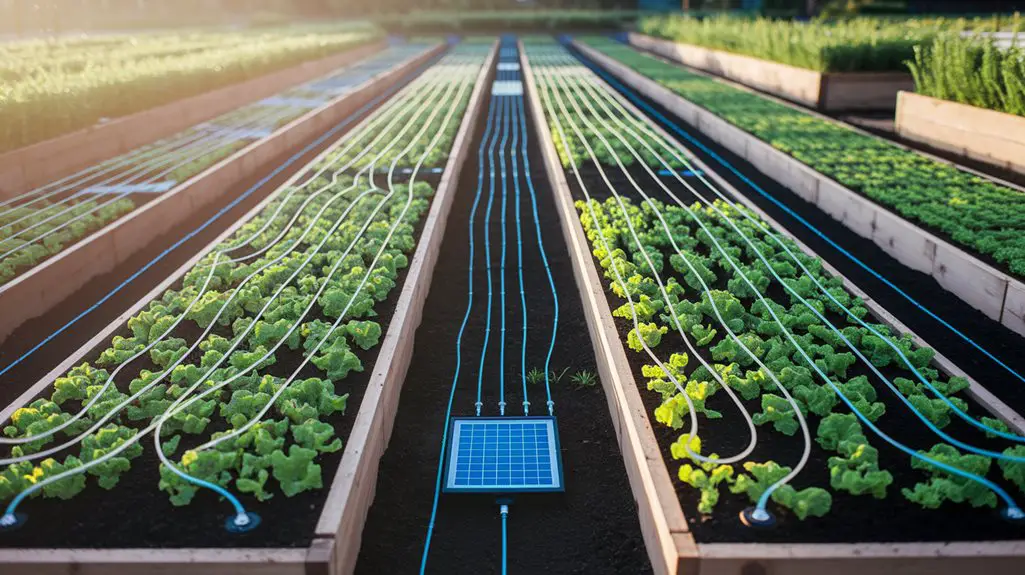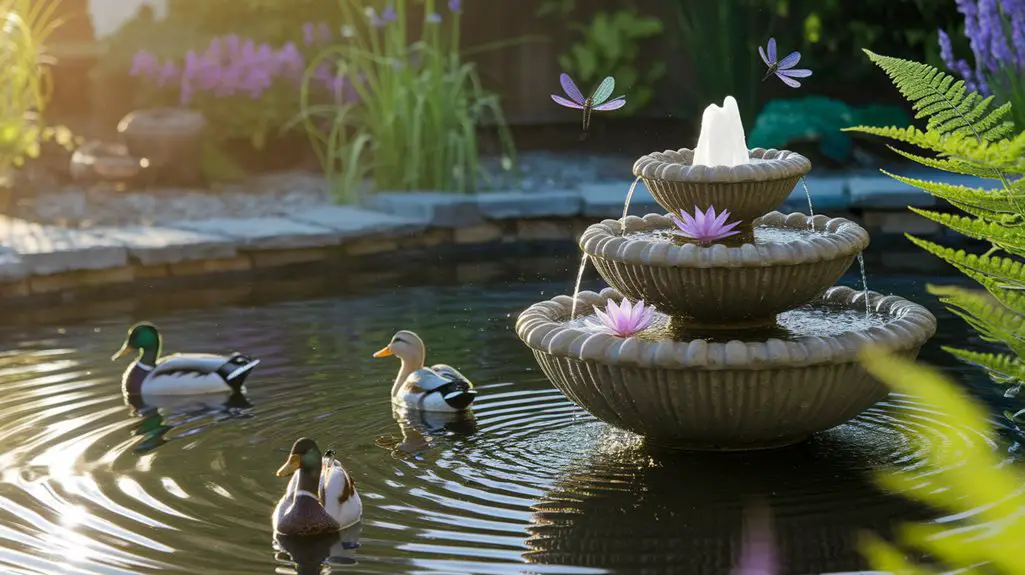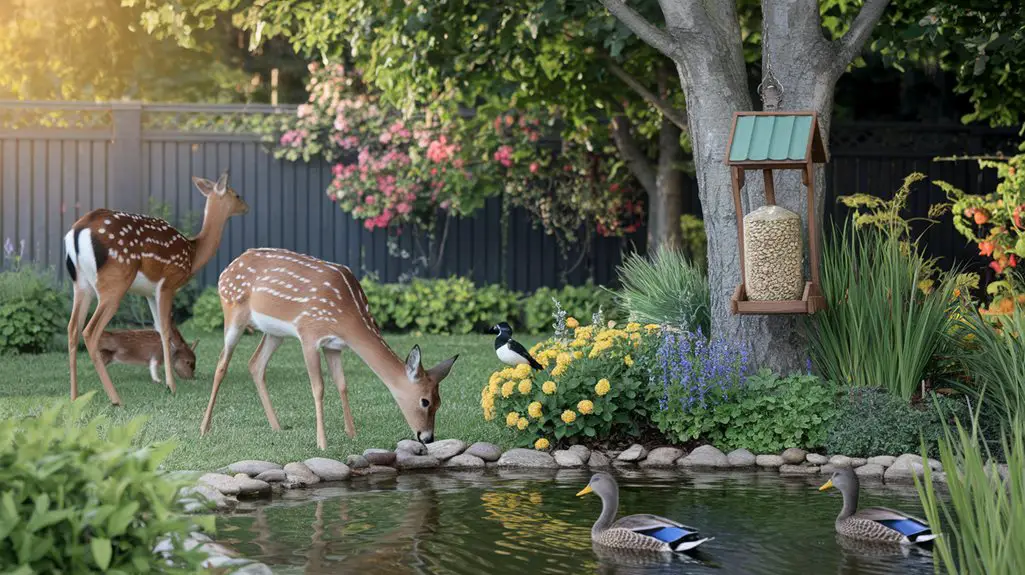Most garden irrigation systems waste between 30-50% of water through evaporation, runoff, and inaccurate distribution. You've likely noticed your water bills climbing during hot months despite your best conservation efforts. Modern water-saving irrigation technologies don't just reduce consumption—they deliver moisture more effectively while responding intelligently to your garden's specific needs. These innovative solutions can transform your approach to garden hydration while dramatically cutting your environmental footprint and utility costs.
Smart Drip Irrigation Systems With Moisture Sensors
While traditional irrigation methods often waste significant amounts of water through evaporation and runoff, smart drip irrigation systems with moisture sensors deliver water directly to plant root zones at precisely the right time.
These systems consist of a central controller connected to moisture probes inserted into the soil. You'll find they operate on predetermined thresholds—when soil moisture falls below the set level, the system activates automatically.
Modern units often include weather forecasting capabilities, suspending irrigation when rain is imminent.
You can install these systems yourself with basic components: polyethylene tubing, emitters, moisture sensors, and a programmable timer.
For ideal efficiency, position emitters 12-18 inches apart for vegetables and 18-24 inches for perennials and shrubs. This targeted approach reduces water consumption by 30-50% compared to conventional sprinklers.
Rainwater Harvesting and Storage Solutions
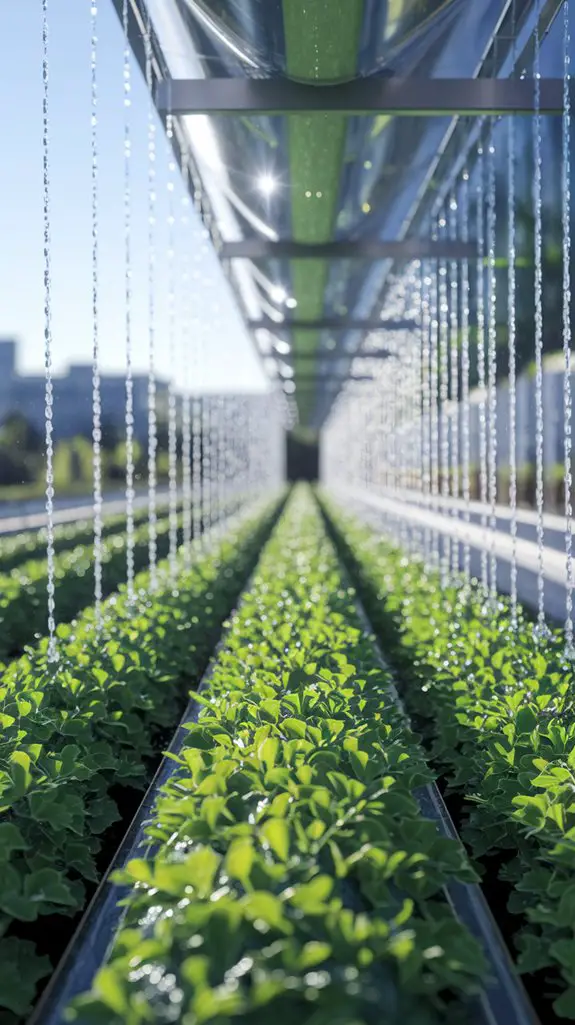
Rainwater harvesting represents one of the most cost-effective methods to supplement your garden's water supply while reducing utility costs.
You'll need basic components: gutters, downspouts, a first-flush diverter, and storage tanks. For peak functionality, install mesh guards over gutters to prevent debris accumulation.
Storage options range from simple rain barrels (50-100 gallons) to underground cisterns (1,000+ gallons).
When selecting a system, calculate your collection potential using this formula: 1 inch of rain on 1,000 square feet of roof yields approximately 620 gallons.
Connect your harvesting system to drip irrigation using a small pump (1/4 HP) for efficient distribution.
For gravity-fed systems, elevate storage tanks at least 2 feet above garden level to maintain adequate pressure.
Consider installing an overflow valve to redirect excess water during heavy rainfall events. Additionally, incorporating creative rainwater collection methods can enhance your system's efficiency and versatility.
Gray Water Recycling for Garden Hydration
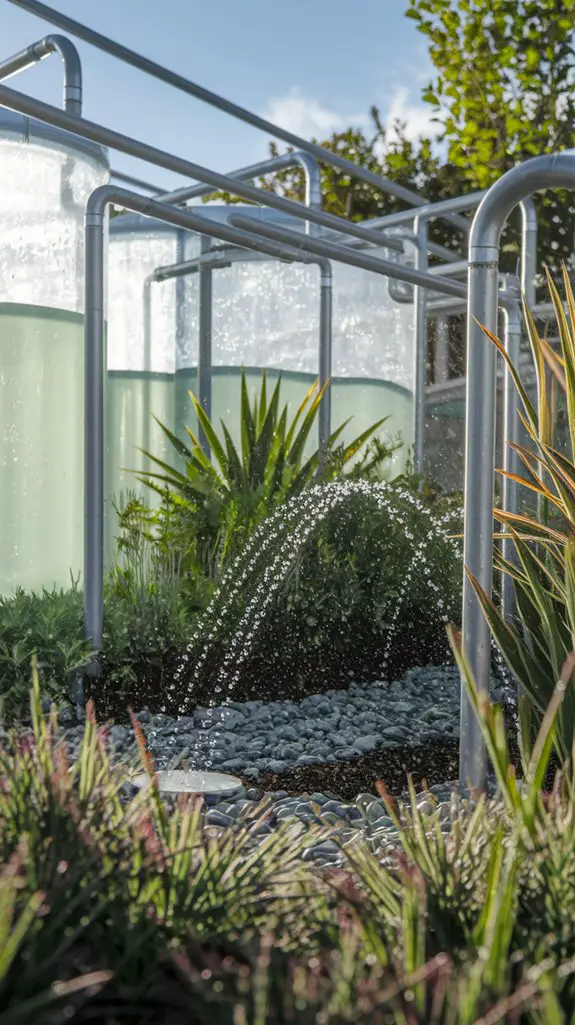
Beyond collecting precipitation, another valuable water source exists within your home. Gray water—the discharge from showers, bathroom sinks, and washing machines—can be redirected to nourish your garden plants instead of flowing into the sewage system.
Install a simple diversion valve to capture this water, ensuring it doesn't contact harmful chemicals like bleach or fabric softeners. You'll need a surge tank to hold the water temporarily before distribution.
For safety, apply gray water directly to soil rather than using sprinklers, as this prevents potential pathogens from aerosolizing.
Focus on irrigating ornamental plants, fruit trees, and shrubs rather than root vegetables or leafy greens. Incorporate mulch basins around plants to filter impurities and regulate water distribution.
Alternate gray water with fresh water occasionally to prevent salt buildup.
Automated Weather-Based Watering Controllers
Although manual irrigation methods offer gardeners direct control, automated weather-based controllers represent a significant technological advancement in garden water conservation.
These smart systems connect to local weather stations or use on-site sensors to monitor temperature, rainfall, humidity, and soil moisture.
You'll find these controllers can reduce water usage by 20-50% compared to traditional timers. They automatically adjust watering schedules based on real-time conditions—skipping irrigation after rainfall or increasing duration during heat waves.
Most units integrate with your smartphone, allowing schedule adjustments from anywhere.
When installing a weather-based controller, place sensors in locations that accurately represent your garden's microclimate.
For maximum efficiency, pair these systems with drip irrigation and group plants with similar water requirements in the same irrigation zones. Additionally, incorporating eco-friendly pest control practices can help maintain a healthy garden ecosystem while conserving water.
Permeable Landscape Design to Maximize Natural Moisture
While automated controllers optimize when and how much water your garden receives, permeable landscape design focuses on naturally capturing and utilizing water that would otherwise run off. This approach incorporates porous materials like gravel pathways, permeable pavers, and rain gardens to allow precipitation to percolate into the soil rather than becoming wasteful runoff.
You'll maximize moisture retention by creating swales—shallow depressions that slow water flow—and berms that direct rainwater to thirsty plants.
Strategic placement of organic mulch (2-3 inches deep) further reduces evaporation while improving soil structure. Consider replacing portions of traditional lawn with drought-tolerant groundcovers that don't require frequent irrigation.
Additionally, implementing sustainable materials in your garden paths can enhance water absorption and contribute to an eco-friendly landscape.
These design elements work together as a system, reducing your garden's supplemental water needs by up to 30% while supporting healthier plant growth.
Self-Watering Planters and Wicking Bed Systems
Self-watering planters and wicking bed systems represent significant advancements in irrigation efficiency because they provide consistent moisture to plant roots while dramatically reducing water consumption.
These systems utilize capillary action to draw water upward from a reservoir into the soil where plants can access it.
You'll find two main components in these systems: a water reservoir at the bottom and a wicking mechanism that connects the reservoir to the growing medium.
As your plants deplete moisture, they automatically receive more from the reservoir. This eliminates both overwatering and underwatering issues.
To maximize efficiency, choose appropriate wicking materials like cotton rope or geotextile fabric, and select the right soil mix that balances water retention with aeration.
You'll typically need to refill these systems just once weekly, saving up to 50% more water than conventional irrigation methods.
Precision Micro-Sprinkler Technology
Unlike traditional sprinklers that disperse water widely and often wastefully, precision micro-sprinkler technology delivers targeted irrigation directly to plant root zones through a network of low-flow emitters.
These systems operate at pressures between 15-30 PSI, distributing water in fine droplets that minimize runoff and evaporation.
You'll find several micro-sprinkler configurations available: stationary, rotating, and misting. Each emitter can be individually adjusted to deliver 0.5-2 gallons per hour, allowing you to tailor water application to specific plants' needs.
When installing, position emitters 12-18 inches apart and connect them to a timer with moisture sensors for ideal automation.
For maximum efficiency, consider sectioning your garden into hydrozones—grouping plants with similar water requirements on the same irrigation line.
Conclusion
By adopting these water-saving irrigation solutions, you'll transform your garden into an incredibly efficient ecosystem while slashing water bills. Smart drip systems, rainwater harvesting, gray water recycling, and weather-based controllers work synergistically with permeable landscapes, self-watering planters, and micro-sprinklers. These technologies deliver precise hydration exactly where and when plants need it—making every precious drop of water count in today's resource-conscious world.

